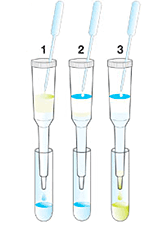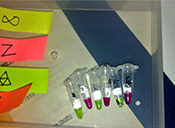Join the Bio-Rad Explorer™ Community to share your knowledge, ideas, and experience and get inspiration, solutions, and information from other educators.
Submit your lesson plans, curricula, and other materials, and view submissions from other educators. How do you present and integrate concepts, develop themes, highlight real-world relevance, and engage students? In addition to providing ideas, using parts of the materials shared here can save you time.
Explore our growing range of materials to assist you in your teaching. Keep checking in to see what’s new. To submit your materials, see the submission instructions at the bottom of this page.
Page Contents

Measuring GFP expression with Vernier's SpectroVis Plus
As a student project, Ben Gansemer, Erica Olson, and Roy Ventullo at Wartburg College in Waverly, Iowa used Vernier's SpectroVis Plus to measure the fluorescence of GFP in E. coli transformed with the pGLO plasmid. They were able to observe the changes in GFP expression and cell growth over time. Download their methods and results to get ideas for student research projects.
Environmental Factors, Inducible Promoters, and Gene Expression
This lesson on environmental influences of gene expression was originally developed by a geneticist-teacher team in the American Society of Human Genetics’ Geneticist-Educator Network of Alliances (GENA) program: Sara Dozier (School of Science and Technology at San Diego High, CA) and Brinda Rana (University of California San Diego, CA). GENA was an NSF-funded partnership program that encouraged teams to build existing resources into inquiry-based lessons that use a learning cycle and address known student misconceptions in genetics. The Bio-Rad pGLO transformation kit is the perfect tool for students studying gene expression in the context of genes responding to environmental stimuli.

This comprehensive lesson plan is expected to take 240 to 250 minutes and is based on the Engage/Explore/Explain/Elaborate/Evaluate learning cycle. In addition to the guided activities, questions, and discussion topics, there are links to supplemental materials. You can download the gene expression lesson plan from the American Society for Human Genetics website.

CureCancer
The CureCancer Unit is a comprehensive lesson plan developed for English language learners (ELL) by Elizabeth Garfinkle (Girl Scout Ambassador) in collaboration with Science Advisor Jessica Sanford (San Roque Elementary School, Santa Barbara, CA) and English Language Learners Advisor Cheryl Takahara (La Patera Elementary School, Goleta, CA).
The Secrets of the Rainforest kit is used as the basis for incorporating English language learning strategies to teach science while making it accessible to ELL. Students practice and expand their communication skills while collaborating in hands-on learning of scientific concepts, vocabulary, and techniques. The CureCancer lesson plan (PDF) includes a suggested timeline, lab prep, unit summary, student booklets, ten individual lesson plans with assignments, diagrams, and projects as well as vocabulary cards (PDF) and a final reflection (PDF).

This lesson plan from Chuck Smith describes the use of the Quantum Prep® plasmid miniprep kit to isolate plasmids followed by agarose gel electrophoresis. The plasmid analysis lesson plan (PDF) includes a step-by-step procedure, a list of follow-up questions, and teacher comments.

Kim Frye from DePaul University suggests using the GMO Investigator™ Kit as a holiday lab. PCR tubes containing the green PSII primers and red GMO primers will surely get your student excited about the festive season and conducting hands-on labs.
Please fill out the submission form and send it along with your files to the email address on the form.
Types of submissions can include lesson plans, curricula, supplemental/extension materials, handouts, slide decks, assessment materials, games/puzzles and videos — anything you think will be of value to other teachers.
Acceptable formats are .txt, .doc, .docx, .jpg, .gif, .png, .mp4, .flv, .swf, .xls, .xlsx, .ppt, .pptx, and .pdf. If separate videos, images, or other materials are uploaded to accompany the text or slides, please make sure that the file names make it obvious that they belong together; please also list the file names in the Comments section of the form.
Please make sure that your contact details are provided (only your name, course, and school information will be posted online). If you want to acknowledge the contributions of others in your submission (other educators, etc.), please list appropriate credits in the Comments section along with any other relevant information.
